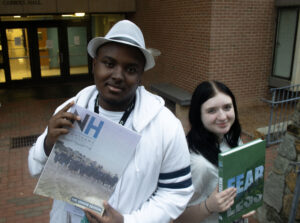Collaboration a growing focus between yearbook and news classes
By Elena Paces-Wiles ’24 and Hannah Posner ’24, Riverside High School

Dogs vs. cats, Duke vs. UNC, Coke vs. Pepsi: among these friendly rivalries is the competition between yearbook and newspaper. High school journalism departments across the state work to find balance amidst the tension.
There is a past of rivalry between yearbook and newspaper, but now, collaboration is becoming a larger focus as teachers are more often teaching both and students are utilizing resources from both yearbook and newspaper classes.
Students enjoy various aspects of both publications and are beginning to realize they can exist in harmony.
“We have published newspapers that talk about difficult topics so I like the fact that we have freedom there,” First Flight High School student Kat Gregg said (‘25). She also enjoys seeing funny yearbook ads throughout the school.
Enloe Magnet High School student, Makaela Council ‘26, likes to look for herself in the yearbook and search for funny pictures. But she loves the newspaper, too.
“I like all the genres,” Council said.”I like reading certain people’s work.”
Fred T. Foard High School student, Julia Farris ‘26, admires “the overarching story and how (the yearbook) can represent us as students.”
But she also appreciates the representation she sees in her school’s newspaper. She enjoys seeing a wide variety of students represented.
Shared resources
Student journalists and advisers at the North Carolina Scholastic Media Institute believe the energy spent on outdated rivalries is better directed towards collaboration.
Former yearbook and newspaper adviser for West Henderson High School, Brenda Gorsuch, dedicated her 34 years to ending the rivalry.
West Henderson dedicates separate classes to newspaper and yearbook, but Gorsuch believes this needs to change. In her role, she wanted to combine the publications into one class. She believes this is a logical solution to both the tension and the scheduling conflicts students in her program faced.
“I thought if we all were working on both (publications) together that it would get rid of that adversarial relationship,” she said. “I think it’s important for journalists to work together.”
Steve Hanf, the newspaper and yearbook advisor for First Flight High School, disagrees with the idea of combining classes. He believes that having separate class periods provides students with more time to complete both publications.
“I like having them separate, but I do love being in charge of both because it just makes things easier,” he said.
First Flight students who are on both staffs often use their newspaper skills to write lengthy yearbook stories. They also share photos between the publications. In doing so, students have been able to publish more work.
Hanf has not observed any tension between First Flight’s two publications.
Learning from each other
After a long history of competition, schools like East Mecklenburg High School and North Buncombe High School noticed a disparity between the programs’ strengths. Yearbook and news students, both broadcast and print, have a lot to learn from each other if they choose to collaborate instead.
Anthony Frederick ‘25, an online editor for East Mecklenburg’s newspaper, wishes the newspaper had access to the yearbook’s superior camera equipment.
Frederick sees potential for the newspaper to teach yearbook staff more graphic design skills and how to summarize effectively.
“I kind of joke that I hate yearbook, but I really do think that since we’re both in the field of writing and chronicling events, there is a lot that we can learn from each other if we were to come together,” he said.
Peyton Webb ‘24 believes yearbook students can learn from the newspaper staff’s collaboration. “They all know they’re going to get a turn so they all work really well together and it shows,” she said.
At North Buncombe, the two publications utilize different interview styles. According to Webb, they could learn interview skills from each other.
Different audiences
According to Frederick, an online editor for East Mecklenburg High School’s newspaper, the two publications are completely separate. Since they do similar things but don’t work together, they often end up in competition.
Although the publications require similar skills, they serve two entirely separate needs of school communities.
“I feel like the newspaper is valuable because there are things going on in the world that students need to know about that they can’t wait a whole year to read about in the yearbook,” Gorush said. “I also feel like the newspaper can take a more honest approach because it is timely.”
At North Buncombe High school, news broadcasts air biweekly, while the yearbook comes out once a year. According to Webb ‘24, they do not compete for student attention due to their different release dates.
Despite the differences, there are still opportunities for both organizations to celebrate success.
“On newspaper distribution days, the yearbook kids should be celebrating and enjoying the newspaper, and on yearbook distribution days, the newspaper kids should be celebrating the yearbook,” Hanf said.
